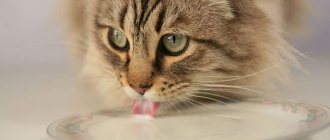Study: Do cats become attached to their owners?
In 2022, a neuropsychological empirical study was conducted at the College of Agriculture from the University of Oregon in the United States in the Human-Animal Interaction Laboratory. The main goal was to identify the main communication styles of cats with their owners. Project leader Christine Vitale and other authors published the results in the journal Current Biology.
During the experiment, the “Ainsworth baseline test” was conducted, previously used in a similar way in studying the behavior of dogs, primates and infants. The cats were left in a new room with the owner for two minutes, followed by a two-minute solo session, followed by a two-minute reunion phase. Both adults and kittens were studied.
It was demonstrated that upon the return of the “caregiver,” cats experienced less stress if a strong attachment had been formed with the owner. They resumed their exploration of the room. But if there were no such friendly relations with a person, then the animals continued to be nervous and showed obvious signs of stress: twitching their tail, avoiding a person, freezing.
This attachment of cats to people is explained by biologically adaptive behavior, since animals live in direct dependence on the owner. It is people who provide their little friends with access to food, water, and safety, that is, they act as a source of comfort. All domesticated animals develop social mechanisms for communicating with humans.
Summary
- Cats really don’t have owners, but they are quite capable of making friends with people.
- To gain the love of a furry pet, it is not enough to feed it, treat it and wash it - communicate with it, play, and spend time.
- If a cat likes you, he will try to be in your company more and more often.
- If you want a particularly warm relationship with your pet, choose one of the most human-friendly breeds.
When using materials from thebestvideo.ru, a link to the source is required.
What influences cats' attachment to humans?
In the above study, of 70 kittens, 64.3% were classified as “attached to people” - they were overjoyed at the return of their owner after being alone in the experimental room. The rest did not show a lack of attention to the person, but simply weak positive emotions. But they were still observed! Surprisingly, the same percentage distribution of attachment is observed in infants.
Animal psychologists decided to check whether the socialization of more independent kittens would affect their attitude towards the owner. They were taught and trained for six weeks, but no significant differences were demonstrated afterward. Thus, if the style of communication with the owner was formed at the beginning of acquaintance, then, apparently, it remains unchanged over time. Although there are many cases where some kind of “friendship” could be achieved even with wild animals.
Take, for example, the stories of the famous veterinarian and writer James Herriot, who was able to gain the trust of two wild felines that settled in his yard. After a few months, he was able to pet them, and one cat even began to press its forehead to his face. Although the furry tramps did not want to settle in the house. But for this he needed weeks of daily feeding and extreme caution. In any case, it was not a strong attachment, but still a trusting relationship and tenderness.
How to make friends with a cat from the very beginning
To do this, you need to know several postulates and try to follow them:
- respect for freedom - you cannot physically hold an animal in your hands or stroke it against its will;
- a sense of security - if a cat wants to sit under the sofa or behind the refrigerator in a new house, but only chooses to eat at night, then you cannot rush it;
- patience - physical punishment is more effectively replaced with positive reinforcement;
- affection and joint leisure - games with the owner and feeding from the palm will allow you to gain trust and interest on the part of the pet;
- maintaining friendship - even a single instance of physical punishment or insult can alienate a cat forever. In any dangerous situation, she should see the owner as a protector.
The first positive experience of communication between a kitten and a person in the first 6–8 weeks after birth is important, so that it then seeks communication with its owner. By the way, cats can also become attached to other species, such as dogs, which makes them “social generalists.”
How to make friends with a cat
It is possible to become someone close to your pet. But just feeding, washing the tray and other actions to take care of him is not enough for this. You need to spend more time with the cat - play with him, stroke him when he is ready for affection, do not chase him away when he wants to lie next to you or even on you.
All this also does not guarantee that you will be able to make friends with a cat, because these animals are very capricious. But it significantly increases your chances of finding a common language with your furry pet.
Do cats bond with their owners in the same way as dogs?
Unfortunately, the answer to this question is ambiguous. In early studies, cats were considered to be more independent creatures than dogs. Demonstration of stress reactions after the owner's departure was perceived as an acquired reflex and a manifestation of a feeling of dissatisfaction. This is explained by the fact that dogs were domesticated much earlier; moreover, cats were not intended to live directly near humans, therefore contact with the owner is not necessary.
In fact, the evolution of dogs and people has been going on together for many centuries, and besides, dogs are initially pack animals, so it is easier to understand their behavior. Dogs have even developed additional facial muscles that allow them to make expressions that make a person want to care and encourage. Cats do not have this, so their facial expression is more often perceived as “arrogant” or “unfriendly.”
Felines were originally loners, but they also demonstrated a variety of social abilities. The importance of social interaction and establishing an emotional connection between them and people cannot be underestimated. The more we know about the formation of such relationships, the easier it will be to solve the problems of complex behavior in pets picked up from the street or adopted from a shelter.
The topic requires additional research, but the latest data suggests that cats are no less sensitive to separation from their owners than dogs, which means they also become attached to their owners. It is worth remembering that each pet is individual and may well be included in the 35% that treat people with some coolness.
The most loyal cats to people
Behavioral characteristics, including attachment to humans, really vary among different breeds of cats. For example, Siamese, Amur and Norwegian cats, as well as any hybrids of domestic and wild cats, are considered the least friendly.
And these breeds have the greatest affection for “two-legged”:
- Sphinx;
- Regdol;
- Abyssinian;
- Burmese;
- British;
- Bengal.
Of course, we should not forget about the individual characteristics of each animal. You may well meet, for example, a very friendly Siamese and a Sphynx who is extremely indifferent to people.
How cats show love to their owner
Biased expectations about cat behavior can disrupt any interaction. Even the most independent cat shows her love, albeit in a strange way. How they do it:
- turning your back to the owner and climbing your hind paws almost onto the face is a sign of trust and relaxation;
- a squinted gaze is a demonstration of love and contentment;
- a cat rubs against its owner - a sign of unity;
- trampling on the chest;
- "butting" the head;
- loud rumbling;
- sleeping next to the owner;
- licking hands or hair;
- “gifts” in the form of loot, left in a visible place.
Therefore, we can confidently say that cats become attached to their owners. This is how they adapted to life side by side with humans. Therefore, it can be argued that most of our furry and not so furry friends truly appreciate their owners and retain friendly feelings towards them for life.
Don’t be upset if the cat lazily stretches when the owner comes home from work or continues to quietly lie on the sofa. This also demonstrates joy. Just in a different way.
Should you talk to your cat?
We all feel the need to get into the inner world of our cats and understand what they are thinking, but is it possible to truly communicate with them? Are they able to understand what we are talking to them about, and vice versa?
The beauty of the relationship between humans and cats is that they thrive without a common language. These animals can communicate their desires through signals, and the owner misunderstands this “message” and responds accordingly, without understanding what is required of him. If the person turns out to be flexible enough, cats will stubbornly continue trying to convey information to him until they succeed. They are very lenient towards our stupidity!
By communicating with their owners, cats also learn the new nature of relationships through trial and error. Learning is possible only when certain actions lead to positive results. For example, if a cat meows when it enters the kitchen (with the intention of telling the owner that a stranger has entered the garden), a person may think that it is time to feed the cat. If this happens repeatedly, then the animal understands that it is enough to go to the kitchen and meow in order to get an extra portion of food. In such situations, there is a risk of obesity, which will lead to health problems.
The moral of the story is: not every meow is a request for food... at least not at first!
Rules of cat etiquette
And finally, if you want to please your pet, you should adhere to several rules:
- it is necessary to allow the cat to determine the nature of the relationship; the cat always makes the first step;
- you should not disturb the cat when it is sleeping or resting;
- if the cat is hiding in a high place - on a closet, rack or shelf, you need to pretend that it is not visible at all;
- the personal space where the cat rests loses its function if it is disturbed there;
- in the cat world it is not customary to demonstrate tenderness too intrusively;
- You should not stare at a cat when it enters a room - most of them would rather leave than remain in the spotlight.
Expressing love through play
People often believe that love can only be expressed through tactile sensations, carrying pets in their arms and stroking them every minute. Unfortunately, this behavior is only permissible in relation to the most socialized and patient cats, since everyone else perceives it as a restriction of freedom and interference in their “personal” life.
You can only evoke positive emotions in your pet, express your love for him and strengthen the bond with the help of a game that reproduces the behavior of a predator during a hunt. Cats appreciate this model of human behavior and “reward” him with their attention in the most natural way.
Busy people include playing with a pet in their daily routine quite rarely, and only in those cases when they have a desire. This may not happen at the most convenient time for the cat, since she also has a certain schedule of activity and rest. Your pet may not show any desire to play, for example, in the afternoon, since he is used to sleeping at this time. It is better to choose the time for play in the late afternoon, when the cat rushes around the house with warlike cries.
The playing time should not be delayed; the most beneficial results are frequent and energetic bursts of activity. Six five-minute games with a toy tied to a fishing rod are more effective than half an hour swinging a rag mouse in front of a bored cat.











